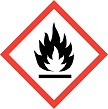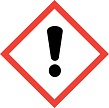GHS Classification Result
PHYSICAL HAZARDS
HEALTH HAZARDS
ENVIRONMENTAL HAZARDS
NOTE:
Reference:
Chemical Name:Triethoxymethane
CAS:122-51-0
Result:
| ID: | 21A3606 |
| Classifier: | Ministry of Health, Labour and Welfare (MHLW), Ministry of the Environment (MOE) |
| Year Classified: | FY2009 |
| Reference Manual: | GHS Classification Guidance by the Japanese Government (March, 2009) |
PHYSICAL HAZARDS
| Hazard class | Classification | Symbol | Signal word | Hazard statement | Precautionary statement | Rationale for the classification | |
|---|---|---|---|---|---|---|---|
| 1 | Explosives | Not applicable | - | - | - | - | There are no chemical groups associated with explosive properties present in the molecules. |
| 2 | Flammable gases (including chemically unstable gases) | Not applicable | - | - | - | - | Liquid (GHS definition) |
| 3 | Aerosols | Not applicable | - | - | - | - | Not aerosol products. |
| 4 | Oxidizing gases | Not applicable | - | - | - | - | Liquid (GHS definition) |
| 5 | Gases under pressure | Not applicable | - | - | - | - | Liquid (GHS definition) |
| 6 | Flammable liquids | Category 3 |

|
Warning | H226: Flammable liquid and vapour |
P303+P361+P353: IF ON SKIN (or hair): Remove/Take off immediately all contaminated clothing. Rinse skin with water/shower. P370+P378: In case of fire: Use ... for extinction. P403+P235: Store in a well-ventilated place. Keep cool. P210: Keep away from heat/sparks/open flames/hot surfaces. - No smoking. P233: Keep container tightly closed. P240: Ground/bond container and receiving equipment. P241: Use explosion-proof electrical/ventilating/lighting/.../equipment. P242: Use only non-sparking tools. P243: Take precautionary measures against static discharge. P280: Wear protective gloves/protective clothing/eye protection/face protection. P501: Dispose of contents/container to ... |
Classified into Category 3 since flash point 30 degC (closed-cup) (Sax (11th, 2004)) is >=23 degC and <=60 degC. The substance is classified into Class 3, PG III in UNRTDG (UN2524). |
| 7 | Flammable solids | Not applicable | - | - | - | - | Liquid (GHS definition) |
| 8 | Self-reactive substances and mixtures | Not applicable | - | - | - | - | There are no chemical groups present in the molecule associated with explosive or self-reactive properties. |
| 9 | Pyrophoric liquids | Not classified | - | - | - | - | Auto-ignition point is 180 degC (Hommel (1996)) exceeding 70 degC. |
| 10 | Pyrophoric solids | Not applicable | - | - | - | - | Liquid (GHS definition) |
| 11 | Self-heating substances and mixtures | Classification not possible | - | - | - | - | Test methods applicable to liquid substances are not available. |
| 12 | Substances and mixtures which, in contact with water, emit flammable gases | Not applicable | - | - | - | - | The chemical structure of the substance does not contain metals or metalloids (B, Si, P, Ge, As, Se, Sn, Sb, Te, Bi, Po, At). |
| 13 | Oxidizing liquids | Not applicable | - | - | - | - | The substance is an organic compound containing oxygen (but not fluorine or chlorine) which is chemically bonded only to carbon. |
| 14 | Oxidizing solids | Not applicable | - | - | - | - | Liquid (GHS definition) |
| 15 | Organic peroxides | Not applicable | - | - | - | - | Organic compounds containing no bivalent -O-O- structure |
| 16 | Corrosive to metals | Classification not possible | - | - | - | - | No data available. |
| Hazard class | Classification | Symbol | Signal word | Hazard statement | Precautionary statement | Rationale for the classification | |
|---|---|---|---|---|---|---|---|
| 1 | Acute toxicity (Oral) | Not classified | - | - | - | - | Based on a LD50 value of 3.2 - 6.4 g/kg for rats (PATTY (5th, 2001)), the substance was classified into "Not classified" in JIS Classification (correspond to Category 5 or "Not classified" in GHS classification). |
| 1 | Acute toxicity (Dermal) | Not classified | - | - | - | - | Based on a LD50 value of 18000 mg/kg for rabbits (IUCLID (2000)), the substance was classified as "Not classified". |
| 1 | Acute toxicity (Inhalation: Gases) | Not applicable | - | - | - | - | Liquid (GHS definition) |
| 1 | Acute toxicity (Inhalation: Vapours) | Category 4 |

|
Warning | H332: Harmful if inhaled |
P304+P340: IF INHALED: Remove victim to fresh air and keep at rest in a position comfortable for breathing. P261: Avoid breathing dust/fume/gas/mist/vapours/spray. P271: Use only outdoors or in a well-ventilated area. P312: Call a POISON CENTER or doctor/physician if you feel unwell. |
Based on a LC50 value of 4000 ppm/8h (5656 ppm/4h) for rats (IUCLID (2000)), the substance was classified into Category 4. Since the LC50 value (4000 ppm/8h) was lower than 90% of saturated vapour pressure concentration (5078 ppm), the classification criteria for gas was adopted. |
| 1 | Acute toxicity (Inhalation: Dusts and mists) | Classification not possible | - | - | - | - | No data available. |
| 2 | Skin corrosion/irritation | Not classified | - | - | - | - | Based on a result of "not irritating" in a rabbit test (OECD TG404 (GLP)) (IUCLID (2000)), the substance was classified as "Not classified". |
| 3 | Serious eye damage/eye irritation | Not classified | - | - | - | - | Based on a result of "not irritating" in a rabbit test (OECD TG405) where corneal opacity, iritis, conjunctivae redness and chemosis scores were 0, 0, 1.44 and 1.00, respectively, (IUCLID (2000)), the substance was classified as "Not classified". |
| 4 | Respiratory sensitization | Classification not possible | - | - | - | - | No data available. |
| 4 | Skin sensitization | Not classified | - | - | - | - | Based on a result of not sensitizing (positive ratio: 0%, 0/20 animals) in a guinea pig maximization test (OECD TG406 (GLP)) (IUCLID (2000)) and information that no skin sensitization was noted in a maximization test on 26 volunteers (IUCLID (2000)), the substance was classified as "Not classified". |
| 5 | Germ cell mutagenicity | Classification not possible | - | - | - | - | Classification not possible due to lack of data from in vivo mutagenicity tests. From in vitro mutagenicity tests, there is a report of a negative Ames test (IUCLID (2000)). |
| 6 | Carcinogenicity | Classification not possible | - | - | - | - | No data available. |
| 7 | Reproductive toxicity | Classification not possible | - | - | - | - | No data available. |
| 8 | Specific target organ toxicity - Single exposure | Classification not possible | - | - | - | - | No data available. |
| 9 | Specific target organ toxicity - Repeated exposure | Classification not possible | - | - | - | - | No data available. |
| 10 | Aspiration hazard | Classification not possible | - | - | - | - | No data available. |
| Hazard class | Classification | Symbol | Signal word | Hazard statement | Precautionary statement | Rationale for the classification | |
|---|---|---|---|---|---|---|---|
| 11 | Hazardous to the aquatic environment (Acute) | Classification not possible | - | - | - | - | Classification not possible due to lack of data. |
| 11 | Hazardous to the aquatic environment (Long-term) | Classification not possible | - | - | - | - | Classification not possible due to lack of data. |
NOTE:
|
* Classification was conducted by relevant Japanese Ministries in accordance with GHS Classification Guidance for the Japanese Government, and is intended to provide a reference for preparing GHS labelling and SDS for users. * This is a provisional English translation of classification results and is subject to revision without notice. * The responsibility for any resulting GHS labelling and SDS referenced from this site is with users. |
Reference:
|
Reference Manual |
|
|
Definitions / Abbreviations |
|
|
Model Label by MHLW |
MHLW Website (in Japanese Only) |
|
Model SDS by MHLW |
MHLW Website (in Japanese Only) |